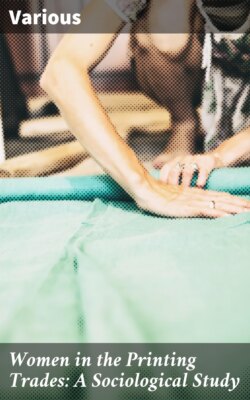Читать книгу Women in the Printing Trades: A Sociological Study - Various - Страница 4
INTRODUCTION.
ОглавлениеThe investigation upon which this book is based was undertaken by the Women's Industrial Council; the Royal Statistical Society, the Royal Economic Society, and the Hutchinson Trustees consenting to be represented on the Committee responsible for the work. Upon this Committee, the Women's Industrial Council was represented by Miss A. Black, Miss C. Black, Mrs. Hammond, Mr. Stephen N. Fox, and Mr. J. Ramsay Macdonald; the Royal Statistical Society by Mr. J. A. Baines; the Royal Economic Society by Professor F. Y. Edgeworth, and the Hutchinson Trustees by Mr. A. L. Bowley. Mrs. Hogg also represented the Women's Industrial Council up to her death in 1900.
The Committee takes this opportunity of thanking the Hutchinson Trustees for their liberal financial assistance, and of expressing its appreciation of the services so carefully and enthusiastically performed by the investigators, especially those of Mrs. Hammond, who is mainly responsible for the work done in London; of Mrs. Oakeshott, who assisted Mrs. Hammond; of Mrs. Muirhead, who supplied information about Birmingham; of Miss Harrison, who investigated Bristol and the South-West, and Leeds and district; and of Miss Irwin and Mr. Jones, who were in charge of the Scottish enquiries. To the many employers, Trade Union secretaries, and others who were so willing to give assistance to the investigators, the Committee also desires to express its gratitude.
Whoever has had experience in collecting and sifting such evidence as is dealt with in this investigation knows how difficult it is to arrive at proper values and just conclusions. And women's trades seem to offer special difficulties of this kind. There are no Trade Union conditions, no general trade rules, no uniformity in apprenticeships, so far as the woman worker is concerned, and the variations in conditions are most striking, even between neighbouring employers drawing their supply of labour from practically the same district, though perhaps not from the same social strata. That difference in strata is in some cases a predominating factor in women's employment, and it everywhere confuses economic and industrial considerations. When to this irregularity of conditions is added a reticence as to "one's personal affairs," due partly to women's lack of the sense that their position is of public interest, and also partly to an unwillingness shown by many employers to disclose the facts of cheap labour, it can readily be seen that the Committee had to exercise the greatest care in its work.
When the investigation was begun there was an idea that it should be the commencement of an enquiry into women's labour in every trade of any importance, but whether that will be carried on or not will now depend on the reception of this volume and on what further financial assistance is forthcoming. The group of trades selected for first treatment shows neither an overwhelming preponderance of women nor a very marked increase in the employment of women. But it illustrates in a specially normal way the main problems of women's labour under ordinary modern conditions. Upon one important point this group does not throw much light. The employment of Women in the Printing Trades does not show to any satisfactory extent the family influence of married and unmarried women wage earners. What information the Committee was able to gather is dealt with in its proper place, but careful enquiries will have to be made in the highly-organised factory industries before that wealth of fact can be obtained from which conclusions can be drawn, with details properly filled in, regarding the influence of women's earnings upon family incomes.
In other respects these trades have yielded most interesting information. They illustrate the industrial mind and capacity of women in the different aspects of training, rates of pay, competition with men, influence of machinery, effect of legislation, and so on. These subjects are dealt with under separate chapters, and though it has been the chief aim of the Committee to present well-sifted and reliable facts, it has stated some conclusions which are most obvious, and which appear to be necessary, if bare figures and dry industrial data are to carry any sociological enlightenment. The volume is therefore offered not as a mere description of industrial organisation, but as a study in sociology which indicates a path ahead as well as points out where we stand at the moment.
Miss Clementina Black is responsible for the description of the Trades, Mr. A. L. Bowley for the Chapter on Wages, and Mr. Stephen Fox for the legal and historical part of that on Legislation. For the rest, the Editor is responsible.
